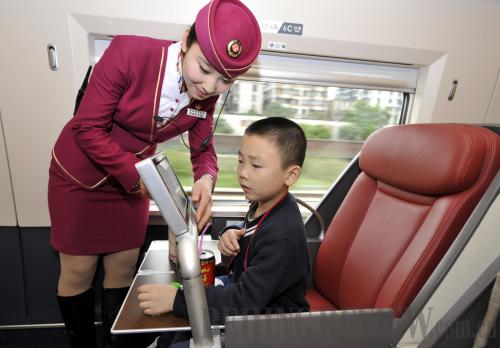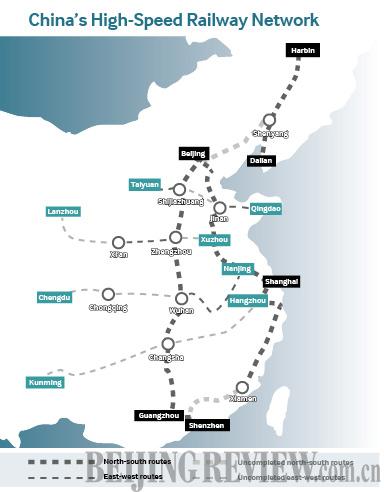|
 |
|
EXPERIENCING BUSINESS CLASS: A stewardess helps a boy adjust his TV during a test run of the Beijing-Guangzhou high-speed railway on December 22 (CHEN YEHUA) |
Given how time-consuming it can be to travel through airports—checking in, security checks and possible flight delays—the airline industry may suffer if more passengers turn to high-speed rail, especially for shorter routes. The challenge faced by airlines, however, may also provide an opportunity for the industry to better integrate airline networks and improve its efficiency and services.
Tackling special conditions
To cope with unique geographical conditions along the Beijing-Guangzhou route, various solutions have been found for concerns like subgrade construction on soft soil.
Furthermore, bridges made to especially handle the high-speed rail line have been developed over the Yangtze River and the Yellow River. The Wuhan Tianxingzhou Bridge over the Yangtze River has the world's largest span of 504 meters. The underground tunnel in Shijiazhuang, capital of Hebei Province, with a total length of 4.98 km and six tracks, is the most complicated design among railway tunnels in China.
Significant gains have also been made on construction of high-speed rails. The tracks along the newly opened Harbin-Dalian high-speed railway were built to cope with the frigid temperatures of China's more remote northeast.The Harbin-Dalian line is the only high-speed railway in the world designed for a high-latitude region, where temperatures in winter can drop to minus 40 degrees Celsius. Snow melting and anti-freeze properties are built into the roadbed and power substations.
Controversies remain
Guangdong, dubbed China's manufacturing powerhouse, is a source of China's Spring Festival rush, also known as the greatest migration of people in the world. According to statistics from the Department of Human Resources and Social Security of Guangdong Province, Guangdong was home to 26 million migrant workers in the past two years. During the 40-day Spring Festival in 2012, Guangzhou saw over 28 million departures.
Many believe that the new Beijing-Guangzhou line will lure passengers away from other conventional, slower lines along the route, which are already overflowing with passengers during the festival period.
"For the coming Spring Festival rush in January, the trains should be less crowded than usual," said Zhao, adding that dozens of trains a day—each with a seating capacity of 1,000—are expected to travel between Guangzhou and Beijing everyday.
Ticket prices, however, have been criticized for being too high. The ticket price for the Beijing-Guangzhou high-speed railway ranges from 865 yuan ($139) for a seat in second-class to 2,727 yuan ($437) for one in business class.
Some netizens have called for the Ministry of Railways to publish the operating cost for the Beijing-Guangzhou line to explain the ticket prices.
"Reasonable prices can be worked by taking passenger flow and future income levels into account," says Xu Fengxian, a research fellow with the Institute of Economics at the Chinese Academy of Social Sciences. " Right now, common people cannot afford such prices."
Tian Fengshao, a research fellow at the Institute of Sociology at Henan University, argued that though ticket prices may be reduced during the upcoming Spring Festival, travel by high-speed rail should gradually morph into a common means of passenger travel rather than an indicator of social status.
Doubts about safety also run high among the public given the tragedy in July 2011 near Wenzhou, Zhejiang Province, when a bullet train rammed into another train stranded on the track, killing 40 people.
Design flaws, poor management and a mishandling of equipment struck by lightning were found to the culprits behind the train crash, according to an investigation by the authorities.
Despite a design speed of 350 km/h, Zhao says the operational speed along the Beijing-Guangzhou line will run at 300 km/h to ease any fears of trains running faster than need be.
"Safety is our top priority," he said.
At 5 p.m. on December 26, the first high-speed train arrived in flower-dotted, subtropical Guangzhou on time. The successful launch of the Beijing-Guangzhou high-speed railway will help the country regain its confidence in the development of its high-speed network. Nonetheless, China's high-speed railway development has plenty of work to do to guarantee safety and win the hearts and minds of the Chinese people.
Email us at: dengyaqing@bjreview.com

| 